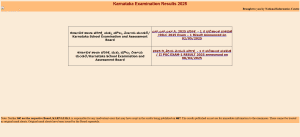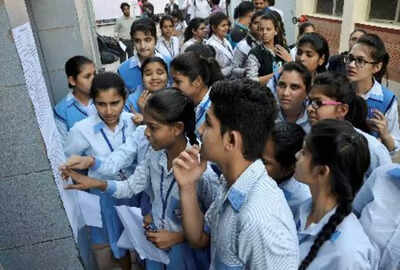The Karnataka School Examination and Assessment Board (KSEAB) announced the SSLC Class 10 results on May 2, 2025, revealing a 62.34% pass rate-a 9% surge from 2023’s 53% but still far below pre-pandemic levels. While 22 students achieved perfect scores (625/625), the results exposed a 15.3% performance gap favoring girls, with coastal districts like Dakshina Kannada (91.12%) dominating the charts. Here’s an in-depth analysis of the trends, challenges, and implications of this year’s SSLC outcomes.
The exceptional performance of coastal districts like Dakshina Kannada and Udupi can be traced to hyper-local community models that prioritize education. Parent-Teacher Associations (PTAs) here operate like think tanks, organizing weekly doubt-solving sessions and career guidance workshops with industry professionals. In contrast, northern districts struggle with low parental literacy rates (below 60% in Yadgir), limiting home-based academic support. NGOs like Akshara Foundation are piloting community libraries and mobile tutoring vans in these regions, but scalability remains a challenge. The state’s new “Edu Champions” program, which incentivizes local leaders to mentor 50 students annually, aims to bridge this gap by 2026.
he SSLC 2025 results revealed a 7.8% pass rate disparity between English (68.9%) and Kannada-medium (61.1%) students, reflecting broader linguistic inequities. While urban centers like Bengaluru have embraced English as a gateway to competitive exams and global opportunities, rural schools often lack proficient English teachers. The government’s “English Lab” initiative, which uses AI chatbots for language practice, has reached only 1,200 of Karnataka’s 12,000 high schools. Advocates demand bilingual textbooks and immersive exchange programs with English-medium institutions to level the playing field. However, traditionalists argue that overemphasis on English risks eroding Kannada’s cultural primacy, sparking debates in the legislature.
Extreme weather events are emerging as silent saboteurs of academic consistency. In 2024-25, 32 schools in flood-prone Kodagu and Chikkamagaluru districts remained shut for over 60 days due to landslides, directly impacting SSLC prep. The state’s “Climate-Resilient Schools” project, which includes raised foundations and solar-powered classrooms, has been implemented in just 150 institutions. With the Indian Meteorological Department (IMD) predicting 20% more erratic monsoons by 2030, educationists urge integrating disaster preparedness into the SSLC curriculum, including survival skills and crisis management modules.
 Key Highlights: Pass Percentage, Gender Gap, and District Rankings
Key Highlights: Pass Percentage, Gender Gap, and District Rankings
-
Overall pass rate: 62.34% (up from 53% in 2024)
-
Girls outperform boys: 70.2% pass rate vs. 54.9% for boys
-
Perfect scorers: 22 students secured 625/625 marks
-
Top districts: Dakshina Kannada (91.12%), Udupi (89.96%), Uttara Kannada (83.19%)
-
Lowest performers: Yadgir (38.1%), Raichur (42.3%), and Kalaburagi (45.6%)
Exam Logistics: Scale and Evaluation Process
The SSLC exams were conducted between March 21 and April 4, 2025, across 2,818 centers with 8.96 lakh candidates-4.61 lakh boys and 4.34 lakh girls. Over 65,000 assessors evaluated answer scripts at 240 centers, adhering to KSEAB’s reformed grading system:
-
A+: 90% and above
-
A: 80–89%
-
B+: 70–79%
-
B: 60–69%
-
C+: 50–59%
-
C: 35–49%
Students needed 35% aggregate marks (minimum 40/150 in theory and 30/50 in practicals) to pass. Borderline cases received grace marks under revised guidelines.
Regional Disparities: Coastal vs. Northern Karnataka
The results highlighted alarming geographical divides:
-
Coastal Dominance: Dakshina Kannada and Udupi maintained their stronghold, with pass rates above 89%. Factors include robust infrastructure, private coaching culture, and parental investment in education.
-
Northern Struggles: Yadgir (38.1%) and Raichur (42.3%) faced challenges such as teacher shortages, inadequate digital access, and socioeconomic barriers.
-
Urban-Rural Gap: Bengaluru Urban reported a 78.3% pass rate, while neighboring rural districts like Ramanagara hovered near 60%.
Gender Dynamics: Why Girls Are Leading
Girls accounted for 70.2% of passes compared to boys’ 54.9%, continuing a decade-long trend. Experts attribute this to:
-
Sociocultural Shifts: Increased parental emphasis on girls’ education as a pathway to financial independence.
-
Academic Support: Targeted scholarships and mentorship programs like Kasturba Gandhi Balika Vidyalaya.
-
Examination Patterns: Subjective assessments favoring consistent performers over rote learners.


Reforms and Controversies
KSEAB’s post-pandemic reforms included:
-
Three-Exam System: Students failing the March-April exams can retake tests in June and July.
-
Grace Marks Policy: Up to 10 additional marks for borderline candidates.
-
Digitization: Online submission of practical records and AI-assisted plagiarism checks.
However, critics argue these measures overlook systemic issues:
-
Infrastructure Gaps: 30% of rural schools lack functional computer labs.
-
Teacher Shortages: Vacancy rates exceed 20% in northern districts.
-
Curriculum Rigidity: Overemphasis on theoretical knowledge at the expense of vocational skills.
Student and Parent Reactions
-
Celebrations in Dakshina Kannada: Topper families credited structured coaching and parental involvement.
-
Frustration in Kalaburagi: Many students cited inadequate access to quality study materials.
-
Mixed Responses to Retests: While some welcomed the three-exam system, others criticized its psychological toll.
Government Response and Next Steps
School Education Minister Madhu Bangarappa acknowledged the improvements but stressed the need for equitable growth:
-
Infrastructure Boost: ₹200 crore allocated for digital classrooms in rural areas.
-
Teacher Training: Partnerships with NCERT for pedagogical workshops.
-
Scholarships: Enhanced financial aid for economically backward students.
The Road Ahead: Bridging Gaps and Building Resilience
While the 9% improvement signals recovery from pandemic-era disruptions, Karnataka’s education system faces three critical challenges:
-
Geographical Equity: Bridging the coastal-northern divide through targeted funding.
-
Digital Inclusion: Expanding e-learning access to rural and tribal areas.
-
Curriculum Modernization: Integrating STEM and vocational training to align with industry demands.
The SSLC 2025 results serve as both a wake-up call and a roadmap for transforming Karnataka into an educationally inclusive state. With focused policies and community engagement, the government aims to achieve an 80% pass rate by 2027, ensuring every student thrives in India’s competitive academic landscape.
Additional Data:
-
Exam 1 Participants: 8,96,447
-
Retest Windows: June 10–20 and July 15–25, 2025
-
Top-Performing Medium: English (68.9% pass rate) vs. Kannada (61.1%)
-
Grace Marks Beneficiaries: ~12,000 students (1.3% of total candidates)
. Infrastructure and Digital Divide: The Hidden Battle in Rural Classrooms


Socioeconomic Factors: Poverty’s Grip on Academic Performance
Economic disparities play a pivotal role in SSLC outcomes. In Kalaburagi, 65% of students come from families earning less than ₹10,000 monthly, forcing many to juggle part-time labor and studies. By contrast, Udupi’s thriving tourism and banking sectors provide families with disposable income to invest in private tutors and coaching centers. The state’s mid-day meal scheme, though critical, often falls short in addressing malnutrition-linked cognitive deficits. Activists urge the expansion of conditional cash transfers, such as the Vidya Vikasa scheme, which offers ₹5,000 annually to low-income students scoring above 80%. However, bureaucratic delays and awareness gaps have left 20% of eligible beneficiaries unenrolled.
Teacher Shortages and Quality: A Systemic Bottleneck
Karnataka faces a 22% vacancy rate in government high schools, with STEM subjects hit hardest. In Raichur, single teachers often manage multiple classes, compromising lesson depth. The state’s decision to hire 3,000 contract educators on a ₹25,000 monthly wage has drawn criticism for perpetuating job insecurity and lowering morale. Meanwhile, coastal districts leverage public-private partnerships to attract qualified teachers, offering housing allowances and upskilling programs. The National Education Policy’s (NEP) emphasis on multidisciplinary training has yet to translate into ground-level improvements, with many rural educators lacking access to modern pedagogical tools.
Vocational Training and NEP Integration: Bridging the Skills Gap
While the SSLC curriculum remains theory-heavy, Karnataka’s pilot initiative to integrate vocational modules in 500 schools shows promise. Students can now opt for courses in AI basics, agricultural robotics, and renewable energy systems, earning dual certifications. However, the program’s urban-centric rollout has excluded tribal schools in Chamarajanagar, where dropout rates exceed 18%. Industry leaders argue that aligning vocational training with local economies-such as textile manufacturing in Ballari or fisheries in Mangaluru-could boost both employability and regional development. The state plans to expand these offerings to 1,000 schools by 2026, pending budget approvals.
Mental Health and Exam Stress: The Silent Epidemic
The three-exam retake system, though lauded for flexibility, has intensified anxiety among students. Counseling centers in Bengaluru report a 40% surge in cases of exam-related panic attacks and insomnia since 2023. Rural areas face acute shortages of mental health professionals, with only 1 counselor per 10,000 students in districts like Bidar. NGOs like The Banyan have launched helplives and peer-support networks, but stigma and limited awareness hinder uptake. Psychologists advocate for mindfulness training and graded assessments to reduce pressure, citing Kerala’s “Happy Schools” model as a blueprint.
Policy Recommendations: Charting a Path to 80% Pass Rates by 2027
Achieving Karnataka’s ambitious target requires multi-pronged interventions:
-
Infrastructure: Fast-track digital classrooms and science labs in 5,000 rural schools by 2026.
-
Teacher Reforms: Convert 50% of contract positions to permanent roles with competitive pay.
-
Nutrition: Expand fortified meals and micronutrient supplements in midday meals.
-
Vocational Ed: Partner with IT giants like Infosys to design localized skill modules.
-
Mental Health: Deploy 1,000 counselors and 500 telemedicine units across government schools.
The SSLC 2025 results are not just a report card but a call to action-one that demands collaboration between policymakers, educators, and communities to transform Karnataka into an equitable education powerhouse.
This expanded analysis delves into the structural, economic, and psychological dimensions shaping Karnataka’s SSLC outcomes, offering a blueprint for systemic change. With targeted investments and community engagement, the state can turn its educational disparities into opportunities for inclusive growth.
This comprehensive analysis underscores the triumphs and trials of Karnataka’s SSLC 2025, offering stakeholders actionable insights to shape the future of education in the state.

